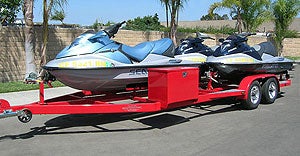The No-Stress Way to Launch A PWC at the Ramp
Get in the water and go!
You’re heart’s racing, your sweating profusely, and you just know all eyes are on you waiting for a mistake. First day on a new job? That weird dream where you’re standing in front of your class in just your underwear? Nah, just another day at the launch ramp for many personal watercraft owners.
For all the fun PWC deliver on the water, they sure can create stress on terra firma. Launching, however, is just like anything else — practice makes perfect. Learn the technique and you’ll be on and off in a minute or so, the hero to every wannabe launch king. Fail to practice and you’ll be that guy — the one who jackknifes his trailer across the ramp, holds up the line forever as he loads his gear, or worse, sends his tow vehicle into the drink along with his PWC.
Ready to take control of the ramp — and your nerves — this season? Follow along…
First Things First

Start by avoiding the ramp all together. Instead, head to an empty parking lot, scout out the lane markers for something resembling the launch lane, and practice your technique.
Don’t try to let anyone tell you the best way to back up a trailer; find your preferred technique and practice. You might, like me, find you back best when draping that right arm across the passenger seat, looking over your right shoulder, and watching the action happen out the back window. Or, maybe you’re the mirrors type. Rather than look behind, you watch the side and rearview mirrors to tell you what position you’re in or where you want to go. Still others swear by keeping one hand at the bottom of the steering wheel; whatever way you turn, the trailer will follow.
Whatever the case, find your technique and stick with it, practicing until you can smoothly and reliably back your trailer between a set number of markings. Can’t find a parking lot with painted lanes or spaces? Grab a cone or milk bottle and make your own barriers. The point is to practice until proficient.
Got it? On to the real deal.
Don’t Fail To Plan
Don’t be caught unprepared at the ramp. Instead, pull over into a designated prep area, or just pull off to the side well before the ramp. Here’s where you clip the lanyard in place, stow your gear and dock lines aboard your craft, screw in the drain plug, maybe even start your craft briefly if you haven’t already warmed it up at home on the flush hose. The point is to do everything you need to do to be ready to ride, and know your boat will start, before you get to the launch lane. Last but not least, put drivers onto your PWC if possible. They should be atop the seat, life jackets on, lanyards attached, ready to back away once in the water.
One, Two, Three…Splash

If you’re certain your PWC will stay put atop the trailer bunks, remove the safety chain and winch strap. If not quite so certain, remove the safety chain, and leave the winch strap loosely in place. This will allow the PWC to float off the trailer once it’s far enough in the water.
If your watercraft is completely loose, have the driver back down the ramp until the trailer fender is just about completely submerged. Start the craft, check for traffic, and then carefully back off the trailer. A little throttle will overcome the friction holding the craft in place atop the bunks.
If you don’t trust your craft to stay put, the driver should set the parking brake, and then carefully (launch ramps are slippery!) walk into the water and unhook the bow of the craft. Again, start up and back away under control.
Get Out Of Dodge
Now, do everyone a favor and get that car off the ramp!
The driver should pull away and park, not pull up and get out to check on the craft, and not pull up and start unloading gear. Pull completely off the ramp so that the next person in line can have their turn.
If you’re the one on the watercraft, wait for your friend to return, then pull around to the dock to pick them up.
The same technique, just in reverse, applies to the return trip. Drop off the driver, then move away from the ramp. When your driver pulls into position, gently motor your PWC onto the trailer bunks, have the driver attach the winch strap (or you can do it if your trailer has a safe area to walk on), then sit down as the driver pulls forward off the ramp and out of the way for unloading.
Quick and easy.
Oh Solo Me-O
Launching alone? Here’s a tip. Attach a length of dock line to the bow hook, set it in the footwell, and back closely parallel to the dock. Put the boat far enough in the water to float, set the parking brake, and get out of the car. Walk to the boat, lean over to un-strap it from the trailer, and use the dock line to walk the boat off the trailer, pulling it around to the opposite or far side of the dock and tying it off to a cleat or piling.
Now, take your lanyard or set the security code, and go park the car. You’re out of the way in short order, your craft is in the water, and no one’s waiting impatiently dreaming up imaginative new ways to string together curse words.
At the launch ramp, that’s a success in anyone’s book.
Get PersonalWatercraft.com in your Inbox!
Like PersonalWatercraft.com on Facebook
Comments
Most Popular

2025 Yamaha JetBlaster PRO 2-Up Review

2024 Kawasaki Jet Ski STX 160X Review

Remembering the Sea-Doo XP

Whatever Happened to the Wetbike?

2025 Yamaha JetBlaster Review













 Your Privacy Choices
Your Privacy Choices